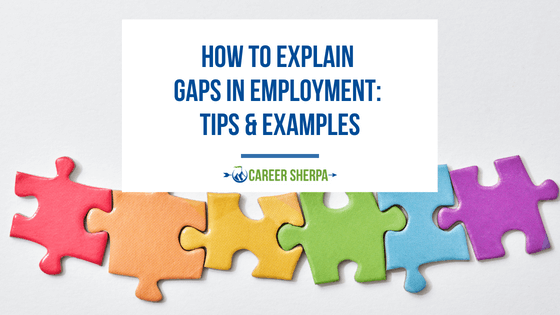Learning how to explain employment gaps is important if you’ve had an extended period of time away from work. All hiring managers and interviewers consider these gaps to be a red (or yellow) flag, so they’ll naturally have some questions.

But don’t worry.
Once you know how to explain employment gaps effectively, you’ll be able to put their mind at ease and move forward with the interview.
Table of contents
What’s Considered an “Employment Gap?”
An employment gap is any period in your professional career where you didn’t have a formal job. When you look at your resume, it should detail your work history in reverse chronological order by month and year. It’s a chronological timeline of your career, and employment gaps typically stand out.
Gaps can vary in length from a few months to several years. Hiring managers will almost always ask about them. They’re common “red flags,” and hiring decision-makers will inquire about them to learn more.
Whatever the case, knowing how to explain employment gaps effectively is incredibly important. They are treated as a cause for concern by default, so you must provide an explanation to ease worries and ensure you’re not taken out of the running for consideration.
How to Explain Employment Gaps
When you have employment gaps in your work history, it can feel like you’re already fighting an uphill battle. But these gaps don’t have to negatively impact your chances of getting hired.
Learn how to explain employment gaps during an interview by following the tips below.
1. Tell the Truth
The most important thing you should do is be honest. It’s tempting to lie when responding to these types of inquiries. Whether you’re ashamed of why you have an employment gap or not, there’s always a nagging feeling that you have to defend yourself.
Brush those feelings off before you enter your interview. Remember why hiring managers ask about it in the first place. It’s not to be accusatory or make you feel like you’ve done something wrong. Companies aren’t so much concerned with the gap itself than what it might represent.
Think of it from a hiring manager’s perspective. They’re trying to get the best person for the job. They want someone qualified and reliable. Plus, they want to bring people in who will support the bottom line and stay with the company for longer than a few months.
When they see that gap in your resume, it casts doubts. That’s fine. It’s your job to reassure them that the lapse won’t affect your performance if you get hired.
That’s the ultimate goal of asking about the employment gap. Hiring managers want reassurance that whatever caused that pause in employment won’t prevent you from being successful now.
Don’t make the mistake of telling tall tales. Lying about the employment gap is one of the worst things you do. Being untruthful will come back to bite you. No matter how much you rehearse your answer, it’s still a gamble.
The hiring manager might decide to do some digging and discover the truth. When they see that you lied, you can kiss that job opportunity goodbye.
It’s much better to remain honest and upfront. Honesty is always the best policy, no matter how awkward that might feel. Even if the reasoning behind the gap is less-than-ideal, you can always frame it as a positive (more on that soon).
2. Determine What Gaps You Don’t Need to Worry About Addressing
Contrary to popular belief, you don’t have to explain every employment gap. In fact, you don’t even need to mention every job on your resume!
If you’re further along in your career, hiring managers aren’t interested in learning about those years you spent hopping around part-time jobs as a teenager. Leave those jobs off your resume so they won’t distract recruiters. They’re interested in your career history and the path you took to get where you are now.
So, what gaps aren’t as important? Generally, anything less than six months isn’t going to be a major concern during interviews. The same goes for gaps that occurred more than a decade ago. Those lapses are in your past and haven’t affected you in a long time, so they’re practically irrelevant.
Here’s a little tip: You can ditch the months in your resume entirely to avoid drawing attention to short breaks of less than six months. Instead of putting the exact date, just write the year.
Short employment gaps aren’t a cause for concern because they’re pretty easy to explain. Sometimes, it takes several months to go through the hiring process and land a job. That’s especially true if you’re already in executive territory.
Most hiring managers will write those gaps off because they can also be due to personal reasons such as illness, pregnancy, and other major life events. Most won’t even bother to bring them up.
3. Show What Relevant Experience & Skills You Gained During the Gap
The best way to explain employment gaps is to talk about what you learned during that time. What skills did you gain, and how will that experience benefit you in the workplace moving forward?
Ultimately, your goal should make this period of time seem like it served a purpose. You want to talk about it in a way that shows it helped you become a better professional in your industry, even if you spend none of that time actively working.
There are many ways to pull this off. The simplest is to talk about skills you obtained during that time. For example, maybe you took a year off and during that time you learned Spanish! Or perhaps you brushed up on relevant software that changed during your absence from the workplace.
You can even talk about soft skills and opportunities you took to push your personal development. Some good examples include learning to be more empathetic, getting used to working solo, and other skills you might need when returning to work.
Find ways to tie everything back to the position you’re trying to get. Soft skills apply to a wide range of jobs, so that tip isn’t as difficult as it seems. Highlight how the employment gap served you, and how it prepared you to get to where you are now.
4. Practice
Please don’t enter your interview without being ready to explain notable employment gaps. You can almost guarantee that questions about your employment gap will come up. Prepare your response ahead of time, keep it concise, and move on.
Understand why the gap occurred and form an explanation that benefits you. It should be positive, focus on what you learned, and be 100 percent honest. You do not need to delve into all the details. Keep it high level.
Go over your explanation with friends and find different ways to say it. Don’t rehearse a scripted answer verbatim. The goal of practicing is to ensure that you know how to deliver a response that sounds confident.
Get comfortable talking about the employment gap, and you can be confident enough not to stumble over your words or say something you regret.
Common Reasons for a Gap in Employment
There are many reasons why an employment gap can occur. Some are within your control, others are not. Having a solid reason for that lapse in work is half the battle when it comes to explaining employment gaps that you might have.
Here are some common reasons that won’t raise any eyebrows.
You Took Medical Leave
Of course, your health is the most important thing. Medical leave is an easy explanation that most hiring managers will recognize without further questions. People have to take extended breaks from work all the time to deal with health issues like cancer, serious bodily injury, and more. You don’t need to disclose the nature of the medical leave, but if possible, let the interviewer know if the condition is resolved.
You Needed to Be a Caretaker for Someone in Your Family
It’s not just your own health that can create an employment gap. Many people have no choice but to become caregivers for sick children, elderly parents, or any other family member. You should include in your answer that you no longer need to be the caretaker so the interviewer doesn’t worry that this will happen again.
Caring for someone else is a full-time job, making gaps necessary.
You Moved
Relocating to a new area is a big deal, although this is less applicable if you’re simply moving to another nearby city. Employment gaps are common when you’re making big moves to another state, country, or continent.
Those moves take time to adjust. Plus, finding work and getting legal matters taken care of can be time-consuming.
You Were Pursuing Formal Education or Career Development
Pursuing your education or developing your career with programs and certifications are excellent reasons to have an employment gap. Hiring managers love to hear when candidates take the initiative to further their career and skillset.
Those endeavors take time and attention, whether getting another degree or doing a certification program. Having a job while doing this can be challenging (and slow you down), so it’s reasonable to take time off.
You Were Looking for a New Job
It’s not always easy to land a job. Depending on your industry and local job market, you could end up waiting months for an opening. Don’t be afraid to talk about that process when explaining an employment gap.
You Were Laid Off
Being laid off is another reason that hiring managers understand. Budget cuts happen, and layoffs are entirely out of your hands. As long as you used your time productively, it’s perfectly reasonable to have a lengthy employment gap.
You Started Your Own Business
If you started your own business, you probably had no choice but to end your formal employment. Continuing to balance your job and your business would be too much to handle. Plus, many organizations would see your continued work as a conflict of interest.
And even if your business idea ended up failing, that’s alright. In fact, it’s safe to assume that it did if you’re interviewing for a job. You can discuss what happened (and what you learned) when explaining the gap.
You may decide to list your business on your resume to help explain this gap.
Opportunities to Explain Gaps in Employment
Now that you know how to explain employment gaps, it’s worth going over situations where you’ll have a chance to do so.
If the gap is significant, you can proactively mention it in your cover letter. Doing so draws the hiring manager’s attention to that point in your resume. By including it in your cover letter, you can explain the gap before it hurts your chances.
Another option is to include it in your work history. Position it as if it were another job. You can use the spot to explain the gap, tell the hiring manager what you did during your time off, and how it affects your work now.
Finally, there’s the interview. It’ll likely come up during your meeting if you don’t explain the employment gap in your resume or cover letter. Have an explanation ready, and you can get it out of the way and move on.
Example Explanations
We have a couple of example explanations to give you a good idea of how to explain employment gaps effectively.
Example 1
In our first example, the job seeker was laid off from a job they held several years ago. Their explanation works well because it addresses the gap briefly, talks about what they did during their time, and effortlessly transitions to discussing the job they’re trying to land.
“That employment gap resulted from being laid off from the job I previously held. I got a lay-off notice without much warning, so I had to spend several months searching for new employment. I began my job search immediately, focusing my efforts on finding supervisor or manager positions.
While I did have several interviews during that lapse in employment, finding the right fit took longer than I anticipated. I eventually found an excellent opportunity to hone my leadership skills. My priorities now are to lead large projects and manage a team directly.
I saw that the job description mentioned mentoring and training new team members. Can you tell me more about that?”
Example 2
The interviewee relocated to a new state in this next example. It didn’t work out, but they talk about how it prepared them for the job they’re trying to get now.
“I had always wanted to live in Seattle. After a lot of thought, I decided to finally follow my dream.
I attempted to find a job while living out of state, but I wasn’t seeing much success. So I decided to move out there and settle in. I waited tables to cover my living expenses while there and while looking for a new job.
During that transition, I acquired many skills I don’t think I would have gained otherwise. I became more aware of servicing customers and managing my time. I’m eager to apply those skills here at [COMPANY].”
Closing Thoughts
Once you know how to explain employment gaps, you’ll be able to ease any worries that interviewers or hiring managers have.
Remember, employment gaps occur all the time. If you’re honest and prepared, you’ll do just fine!

Hannah Morgan speaks and writes about job search and career strategies. She founded CareerSherpa.net to educate professionals on how to maneuver through today’s job search process. Hannah was nominated as a LinkedIn Top Voice in Job Search and Careers and is a regular contributor to US News & World Report. She has been quoted by media outlets, including Forbes, USA Today, Money Magazine, Huffington Post, as well as many other publications. She is also author of The Infographic Resume and co-author of Social Networking for Business Success.
